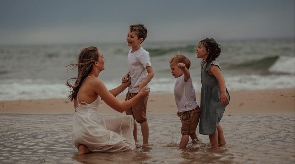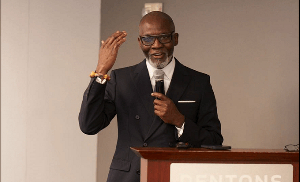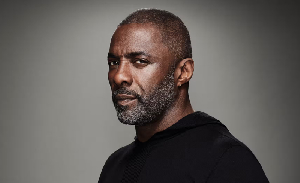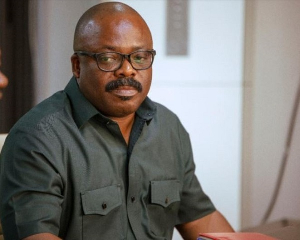"Austin bin dey pretty perfect wen we born am for 38 weeks. Only im liver enzymes dey high small."
Renee Staska third child dey meet all im milestones, dey try stand, dey make eye contact and dey laugh.
Wen im high liver enzymes or proteins no respond to medical treatment, doctors den decide to do some kind gene testing.
"Dey bin call me and say dem don find Niemann-Pick type C. Na one terminal diagnosis."
Niemann-Pick type C (NPC) na one rare, inherited and neurologically progressive disease. Renee don dey enta into di world of childhood dementia.
"I bin just dey dazed from dis news wen di doctor say, 'No google, just go home and love am sake of say no treatment or cure. Notin wey you fit do'."
She den decide to test her two older children, four-year-old Hudson and two-year-old Holly.
Di results dey traumatic.
"Make all three of my pikins dey diagnosed wit terminal illness dey completely shocking to me. I only dey introduced to palliative care."
Wetin be Niemann-Pick type C disease?
One inside 150,000 pipo go get NPC. Di disease dey usually appear for early childhood and di average life expectancy na just nine years of age.
Na di result of two copies of one faulty gene wey dey passed from both parents to di pikin, wey get one inside four chance to get di disease.
Fatty substances dey accumulate for di brain, affect di central nervous system, and different parts of di bodi.
Symptoms of NPC and oda forms of childhood dementia include drop in memory and balance, lung and liver failure, delay in motor development and seizures, according to di British National Health Service.
Di Childhood Dementia Initiative (CDI), one non-governmental organisation for Australia wey wan raise awareness and encourage more research, estimate say around 700,000 children globally dey live wit dementia.
But data from low and middle income kontries dey mostly missing sake of limited access to specialist healthcare and genetic testing.
Five years on from di diagnosis, Renee older son and daughter now don dey show signs of di disease.
"My eldest, Hudson, dey very behind for school. E never dey able to read or write. E dey very impulsive wen e dey cross di road. Im eye movements don decrease, and e also dey tire very often.
"My daughter Holly eyesight don also start to dey affected, she dey fall behind for class and delay dey for her social skills".
Di children regularly get different therapies including hydro speech, occupational and physiotherapy to helep keep dem strong and healthy as possible.
Renee bin stumble upon di CDI group and im founder, Megan Maack, as she dey try make sense of her situation.
Wetin be Sanfilippo syndrome?
Ten years ago, Megan Maack dey live one life of "beautiful chaos", dey juggle one corporate career and two children under five.
Den, her four-year-old daughter Isla dey diagnosed wit Sanfilippo syndrome, anoda rare, genetic condition wey be one type of childhood dementia.
"For di time of diagnosis, Isla bin get small symptoms, mostly developmental delays around language and communication.
"She dey say single words but no dey join dem up. She dey slower dan oda pikins for how to dey pick tins up, and so I go see doctor."
Megan say Isla paediatrician tell her make she no worry.
"But sometin for my gut tell me say e no dey right, and I call am mother intuition. So we bin go one clinic wey do one gene panel test (e look for changes for many genes for one test).
"And thank God say dem do, sake of say we for dey for some more years before we get di diagnosis of Sanfilippo."
Every moment dey precious for Megan as Sanfilippo syndrome currently get no cure, and most children no dey expected to live beyond dia teens.
Soon afta, Meghan two-year-old son Jude dey diagnosed wit di same condition.
"Both my children father and I get mutation for di same gene, and unfortunately pass dat gene wen we conceive di children," she tok.
"Isla use to dey able to read; she fit run, jump, and swim. She bin be dis glorious, sassy, little girl wey love to dress up and make friends."
Children wit Sanfilippo syndrome lack one protein wey dey break down large sugar molecules for di human body, according to di NHS.
As di molecules accumulate for di cells of di body, dem dey cause irreparable damage to all organs including di brain, wey cause widespread inflammation and loss of sensitive brain tissue.
E dey lead to loss of developmental skills, deafness, hyperactivity, behavioural problems and seizures.
"Today Isla be 14 and Jude be 12," Megan tok. "We dey watch dem slowly fade away.
"Isla no dey sabi who I be most days. She don often comot from di house and dey roam around, sometin wey we know say dey happun to plenti adults wey get dementia.
"Pipo dey tok about bereavement wen somebodi die and dey tok about anticipatory grief. We no get word for wetin we dey go through, to lose somebodi little by little," Megan tok.
Need for research
Dr Kristina Elvidge, head of research for CDI, say enof clinical trials no dey take place.
"Na 12 times fewer trials dey take place for childhood dementia dan for childhood cancer," she tok.
"Even though e dey cause similar number of deaths like for childhood cancer for Australia every year."
Dr Brian Bigger, one professor of Cell and Gene Therapy for di University of Manchester, dey study neurodegenerative metabolic diseases wey dey mainly affect children.
"One of di most promising treatments for clinical trial na gene therapies," e tok.
Dis na di repair or replacement of missing genetic material by using one disabled virus.
E get two main types, one wey involve targeted delivery of di genetic material to di bloodstream, spinal column or even di brain.
Di second go need di use of di patient blood stem cells wey dey harvested from bone marrow, and fit become any blood cell type wen e dey developed.
Following infection wit di modified virus, di stem cells wey dem correct go dey returned to di patient bodi.
Di patient must receive chemotherapy so di corrected stem cells fit grow and make healthy cells inside di bodi again. Dis therapy also provide one route enta di brain.
But di treatment dey come wit one big moni.
"One of di problems wey we get wit dis diseases and treatments na say dem dey seriously expensive to bring to market, e dey cost millions of dollars to develop," Prof Bigger tok.
"We don treat five patients for trial and di outcomes for two of di patients - wey dey two years of age dat time -- dey remarkable.
"One of dem fit do complex tasks, like to dey ride scooter, and tok to her broda, and dis skills dey usually limited for Sanfilippo. Di oda child dey compliant, able to wear glasses."
Sanfilippo children fit dey challenging, Prof Bigger tok, so e fit be like one small success, but e dey significant.
However, di researchers also ask for caution as di majority of patients for di clinical trial neva reach di age wia di most serious stages of disease progression typically dey present.
Di Niemann-Pick UK (NPUK) charity dey work closely wit CDI for Australia. E say di umbrella term ‘childhood dementia’ go help raise awareness, and also dey campaign for more govment support.
“E get disconnect between support and services for rare diseases and those for dementia,” NPUK CEO Toni A Mathieson tok.
“We dey ask di UK and Scottish goments to recognise di gravity and urgency of childhood dementia and related ultra-rare conditions, including childhood dementia for dia dementia strategies."
Megan son Jude still dey engage wit di world though im vocabulary don dey limited.
Her daughter Isla don lost almost all her language but fit still say one special word.
"If she dey happy, she go look you for eye, and she go say 'happy'. E go just melt you.
"You dey always look forward to your pikin first word. But you never expect to dey look out for your pikin last word."
BBC Pidgin of Thursday, 21 September 2023
Source: BBC
















